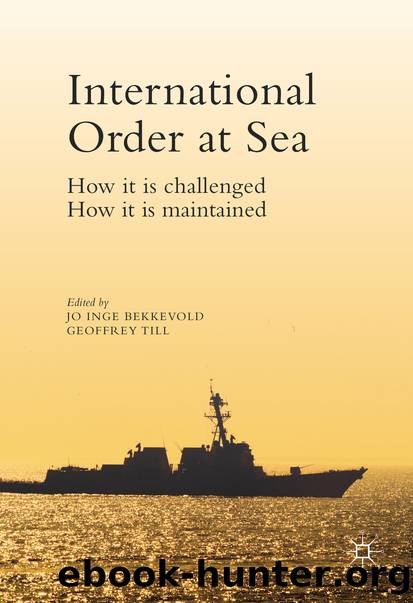International Order at Sea by Jo Inge Bekkevold & Geoffrey Till

Author:Jo Inge Bekkevold & Geoffrey Till
Language: eng
Format: epub
Publisher: Palgrave Macmillan UK, London
Conclusion
The Arctic Ocean as a resource and as a medium of transportation is undergoing extraordinary changes and, given continued climate change, increased activity can be expected. Hence, the international order at sea in the region will most likely evolve, requiring adjustments to its management. One challenge is that the developments in the Arctic and dynamics outside the region which deeply affecting it, are non-linear, malleable, and hard to predict, making adequate, long-term policy responses difficult.
Related to this are the limited response and law enforcement capabilities available today to deal with the increased activity and in worst case, an accident or environmental disaster at sea. There will be a growing demand for constabulary operations, surveillance, protection and enforcement of sovereign rights, enhanced maritime domain awareness to protect international trade and sea lanes of communications, as well as infrastructure on the coast and at sea to prevent and respond to maritime accidents and environmental hazards. This requires changes in the priority, mandate, and capabilities of maritime forces in the region. The challenge is most pressing for Russia and Norway given their extensive maritime territories, but also for the other littoral states. Inter-agency relationships and joint forces are likely to be necessary. The coordination of efforts between some of the Arctic stakeholders, and joint plans with a clear division of responsibilities could reduce spending and duplication of efforts and capacities, thus allowing more efficient use of resources. Increased cooperation in ensuring security and protection could also contribute to enhance regional stability, mutual dependence, and trust.
Another prominent challenge will be to strike the right balance between increased investments in capabilities, activity, exploiting the natural resources and preserving the natural environment, safety, and security without fueling regional insecurities.
A vital task for the Arctic states and other regional stakeholders will be to uphold an effective governance regime. They have all expressed a commitment to maintaining and managing in a predictable manner the international order at sea in the Arctic and the existing multi-layered governance regime. Since the Arctic is a predominantly maritime environment, the UNCLOS constitutes the fundament of its legal regime, complemented by a web of other organizations addressing various problems, including global (e.g. the International Maritime Organization), circumpolar (the Arctic Council), sub-regional (e.g. the Euro-Barents Arctic Council; the Arctic Five as a separate casus group) and bilateral ones (e.g. the Russian–Norwegian Fishery Commission). For the time being, the Arctic states consider this model sufficient and capable of responding to a spectrum of current and emerging new problems in the region (Stokke 2011).
Nonetheless, the governance regime in the Arctic is as stable as the stakeholders are willing to make it. Tensions and conflicts in international relations at large may have unintended negative consequences on Arctic affairs and the ability and willingness of the Arctic stakeholders to work together. As the development in the wake of the 2008 war in Georgia and particularly the 2014 war in Ukraine have demonstrated, the Arctic is inherently connected with other security spaces. Domestic and foreign policy developments in Russia have spurred concerns to what extent Russia is committed to cooperation and international law.
Download
This site does not store any files on its server. We only index and link to content provided by other sites. Please contact the content providers to delete copyright contents if any and email us, we'll remove relevant links or contents immediately.
| Arms Control | Diplomacy |
| Security | Trades & Tariffs |
| Treaties | African |
| Asian | Australian & Oceanian |
| Canadian | Caribbean & Latin American |
| European | Middle Eastern |
| Russian & Former Soviet Union |
The Secret History by Donna Tartt(16620)
The Social Justice Warrior Handbook by Lisa De Pasquale(11489)
Thirteen Reasons Why by Jay Asher(7788)
This Is How You Lose Her by Junot Diaz(5768)
Weapons of Math Destruction by Cathy O'Neil(5035)
Zero to One by Peter Thiel(4823)
The Myth of the Strong Leader by Archie Brown(4789)
Promise Me, Dad by Joe Biden(4446)
Beartown by Fredrik Backman(4415)
Stone's Rules by Roger Stone(4415)
How Democracies Die by Steven Levitsky & Daniel Ziblatt(4398)
The Fire Next Time by James Baldwin(4342)
100 Deadly Skills by Clint Emerson(4076)
A Higher Loyalty: Truth, Lies, and Leadership by James Comey(4032)
Rise and Kill First by Ronen Bergman(4012)
The David Icke Guide to the Global Conspiracy (and how to end it) by David Icke(3881)
The Farm by Tom Rob Smith(3872)
Secrecy World by Jake Bernstein(3782)
The Doomsday Machine by Daniel Ellsberg(3730)
